Wal-Mart Customers Still Waiting for Rural Low-Cost AOL Service
- Share via
PALO ALTO — A year ago, Wal-Mart Stores Inc. and America Online Inc. heralded a new Internet service geared toward customers of the world’s biggest retailer, and rural shoppers in particular.
The co-branded service would bridge the “digital divide” that had thus far kept many rural Americans offline, the companies said. It would offer local dial-up numbers in towns that had none and be priced for the “value-conscious.”
One year has passed since the Dec. 16, 1999, announcement, and Wal-Mart shoppers still are waiting for a dial tone.
“We’re still looking at it, but there’s nothing definite about it at this point,” said Wal-Mart.com spokeswoman Cynthia Lin, declining to elaborate.
Last year, Internet companies from Yahoo Inc. to AOL sought contracts with retailers to compete with low-cost or free online services such as NetZero Inc. Such competition has diminished this year as many free online services struggle to stay in business.
Wal-Mart, meanwhile, has reorganized its Web business, tapping a Silicon Valley venture capital partner with the kind of Internet expertise the Bentonville, Ark.-based retailer lacked.
Palo Alto-based Wal-Mart.com was created Jan. 6, three weeks after the AOL alliance was announced. A co-branded Internet service might no longer fit Wal-Mart’s plans, analysts said.
“I think they quietly let [the idea] die,” said Salomon Smith Barney analyst Richard Church, who rates Wal-Mart shares a “buy.”
Jeanne Jackson, who headed Gap Inc.’s online business and its Banana Republic clothing chain, was hired in March as chief executive of Wal-Mart.com. She didn’t mention the AOL agreement in an October presentation to analysts.
Plans for an Internet-access service remain on the table, AOL spokeswoman Wendy Goldberg said.
“It’s not a delay,” Goldberg said. “We’re working with Wal-Mart to develop the best service for their needs.”
Meanwhile, Dulles, Va.-based AOL has started Internet services with two other major retailers, Sears, Roebuck & Co. and Target Corp., which announced their alliances months after Wal-Mart made its deal public.
Sears, which made its announcement in March, began distributing software for its co-branded Internet service last week, said spokeswoman Ann Woolman. Target stores have carried free software since August, two months after the discount chain announced its partnership with AOL.
The proliferation of Internet service providers, or ISPs, might have caused Wal-Mart to think twice about offering yet another way for consumers to connect to the Web, said Barrett Ladd, senior retail analyst at Internet research firm Gomez Inc.
“There are so many ways to get an ISP--you can get one from your bank, you can get one from your retailer, you can get one on your own,” she said. “I don’t think it’s going to put Wal-Mart at a disadvantage if they don’t come out with an ISP.”
Cost might be an issue as well, analysts said.
Inexpensive or free Internet services such as NetZero and CMGI Inc.’s 1stUp.com expected advertising and e-commerce to offset a lack of subscription revenue. As Internet companies collapsed or cut back spending after Web-related stocks tumbled this year, advertising growth slowed and the free ISPs ran into trouble, analysts said.
“If free access had turned out to be a successful model, then you would have seen AOL be more aggressive,” said ING Barings analyst Youssef Squali. “There’s no free lunch anymore.”
CMGI, an Internet venture capital company, said it would stop operating free online service 1stUp.com by the end of January to cut costs. 1stUp.com had 5.5 million users at the end of September.
Kmart Corp.’s BlueLight.com Internet venture acquired some assets of Spinway Inc., which ran BlueLight’s free ISP, to keep the service alive when Spinway ceased operations on Dec. 1. Kmart started the free service to get customers online and on the BlueLight.com commerce site.
Perhaps Wal-Mart would rather distinguish itself on the Internet by investing in site improvements instead of offering service, Gomez’s Ladd said.
“It seems [an ISP] would be a considerable investment to make sure people are shopping online,” she said. “There are other players who probably have the capital and the interest, more so than a retailer, to invest in that initiative.”
More to Read
Inside the business of entertainment
The Wide Shot brings you news, analysis and insights on everything from streaming wars to production — and what it all means for the future.
You may occasionally receive promotional content from the Los Angeles Times.









